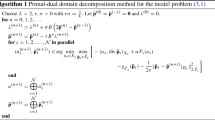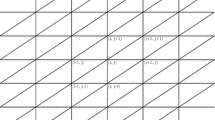Abstract
\(L_1\) regularization is widely used in various applications for sparsifying transform. In Wasserman et al. (J Sci Comput 65(2):533–552, 2015) the reconstruction of Fourier data with \(L_1\) minimization using sparsity of edges was proposed—the sparse PA method. With the sparse PA method, the given Fourier data are reconstructed on a uniform grid through the convex optimization based on the \(L_1\) regularization of the jump function. In this paper, based on the method proposed by Wasserman et al. (J Sci Comput 65(2):533–552, 2015) we propose to use the domain decomposition method to further enhance the quality of the sparse PA method. The main motivation of this paper is to minimize the global effect of strong edges in \(L_1\) regularization that the reconstructed function near weak edges does not benefit from the sparse PA method. For this, we split the given domain into several subdomains and apply \(L_1\) regularization in each subdomain separately. The split function is not necessarily periodic, so we adopt the Fourier continuation method in each subdomain to find the Fourier coefficients defined in the subdomain that are consistent to the given global Fourier data. The numerical results show that the proposed domain decomposition method yields sharp reconstructions near both strong and weak edges. The proposed method is suitable when the reconstruction is required only locally.










Similar content being viewed by others
References
CVX: Matlab software for disciplined convex programming, CVX Research Inc. http://cvxr.com/cvx/ (2016)
Albin, N., Pathmanathan, S.: Discrete periodic extension using an approximate step function. SIAM J. Sci. Comput. 36(2), A668–A692 (2014)
Archibald, R., Gelb, A., Platte, R.B.: Image reconstruction from undersampled Fourier data using the polynomial annihilation transform. J. Sci. Comput. 67(2), 432–452 (2016)
Archibald, R., Gelb, A., Yoon, J.: Polynomial fitting for edge detection in irregularly sampled signals and images. SIAM J. Numer. Anal. 43(1), 259–279 (2005)
Barnard, R.W., Dahlquist, G., Pearce, K., Reichel, L., Richards, K.C.: Gram polynomials and the Kummer function. J. Approx. Theory 94, 128–143 (1998)
Boyd, J.P.: A Comparison of numerical algorithms for Fourier extension of the first, second, and third kinds. J. Comput. Phys. 178, 118–160 (2002)
Bruno, O.P., Lyon, M.: High-order unconditionally stable FC-AD solvers for general smooth domains I Basic elements. J. Comput. Phys. 229, 2009–2033 (2010)
Bruno, O.P., Han, Y., Pohlman, M.M.: Accurate, high-order representation of complex three-dimensional surfaces via Fourier continuation analysis. J. Comput. Phys. 227, 1094–1125 (2007)
Bruno, O.P., Elling, T., Sen, A.: A Fourier continuation method for the solution of elliptic eigenvalue problems in general domains. Math. Probl. Eng. 2015, 1–15 (2015)
Bruno, O.P.: Fast, high-order, high-frequency integral methods for computational acoustics and electromagnetics. Topics in Computational Wave Propagation, Lecture Notes in Computer Science Engineering, vol. 31, pp. 43–82. Springer, Berlin (2003)
Buades, A., Coll, B., Morel, J.-M.: The staircasing effect in neighborhood filters and its solution. IEEE Trans. Imag. Process. 15(6), 1499–1505 (2006)
Donoho, D.: For most large underdetermined systems of linear equations the minimal \(l^1\)-norm solution is also the sparsest solution. Commun. Pure. Appl. Math. 59(6), 797–829 (2006)
Hesthaven, J., Gottlieb, S., Gottlieb, D.: Spectral Methods for Time-Dependent Problems. Cambridge University Press, Cambridge (2007)
Shahbazi, K., Albin, N., Bruno, O.P., Hesthaven, J.S.: Multi-domain Fourier-continuation/WENO hybrid solver for conservation laws. J. Comput. Phys. 230(24), 8779–8796 (2011)
Li, P., Gao, Z., Don, W.-S., Xie, S.: Hybrid Fourier-continuation method and weighted essentially non-oscillatory finite difference scheme for hyperbolic conservation laws in a single-domain framework. J. Sci. Comput. 64, 670–695 (2015)
Lyon, M.: High-order unconditionally-stable FC-AD PDE solvers for general domains. ProQuest Dissertations and Theses (2009)
Ravishankar, S., Bresler, Y.: Learning sparsifying transforms. IEEE Trans. Sig. Process. 61(5), 1072–1086 (2013)
Stefan, W., Renaut, R.A., Gelb, A.: Improved total variation-type regularization using higher order edge detectors. SIAM J. Imaging Sci. 3(2), 232–251 (2010)
Vandeven, H.: Family of spectral filters for discontinuous problems. J. Sci. Comput. 8, 159–192 (1991)
Wasserman, G., Archibald, R., Gelb, A.: Image reconstruction from Fourier data using sparsity of edges polynomial annihilation sparsifying transform. J. Sci. Comput. 65(2), 533–552 (2015)
Acknowledgements
The authors thank Anne Gelb for introducing the sparse PA method and programming and her helpful comments on the manuscript. The authors also thank Wai-Sun Don for helping them to understand and implement the Fourier continuation method.
Author information
Authors and Affiliations
Corresponding author
Appendix
Appendix
The key element of the FC method is to find a smooth matching function. The matching function is not unique but depends on various parameters used. The matching function \(f_{\text {match}}(z) \) is approximated with the Gram polynomials for conditioning purpose defined as below. For more details, see [15].
Definition 2
Gram Polynomials: The Gram polynomials \(P_n(\xi )\), where \(-1\le \xi \le 1\), satisfy the following three-term recurrence relation,
with \(P_{-1}(\xi )=0\), \(P_0(\xi )=\frac{1}{\sqrt{\beta +1}}\) and \(\alpha _{-1}=1\) [5].
Using the Gram polynomials \(P_n(\xi )\)[5] with degree \(M (M\le \beta )\), \(f_{\text {match}}(z^{\text {left}})\) and \(f_{\text {match}}(z^{\text {right}})\), we can obtain the projection coefficients such that
where \(z_i^{\text {left}}=b-\delta +i\Delta x\), \(z_i^{\text {right}}=b+d+i\Delta x\) and \(\xi _i=-1+\frac{2i\Delta x}{\delta }, i=0,\ldots ,\beta \).
To obtain values of the smooth matching function \(f_{\text {match}}(z)\) in the extend domain \(I_1=\left[ b,b+d\right] \) that satisfies the matching condition (13) and to implement efficiently, we use even and odd decompositions and obtain two smaller linear systems [15]. By splitting the original problem into smaller systems, it helps improve the conditioning of the original system. We note that a more flexible and efficient procedure of the discrete periodic extension method can be found in [2]. In this paper, however, we used even odd decompositions found in [15]. Define the even functions \(f_n^{\text {even}}(z)\) and the odd functions \(f_n^{\text {odd}}(z)\).
First, introduce a parameter \(K(K<Q, \text {for an integer } Q \text { much larger than }\beta )\) to enhance accuracy in approximating the Gram polynomials and define the index set t(K) as
Split this index set t(K) into an even index set \(t_{\text {even}}(K)=\{j\in t(K) \mid mod(j,2)=0\}\) and an odd index set \(t_{\text {odd}}(K)=\{j\in t(K) \mid mod(j,2)=1\}\). With these two index sets, we can define the even functions \(f_n^{\text {even}}(z)\) and the odd functions \(f_n^{\text {odd}}(z)\) on uniform grid points \(z^{extend}_i = b+i\Delta x, \; i=1,\ldots ,\gamma -1\), such that,
Here the coefficients \(\{ \hat{a}_k^n,\hat{b}_k^n \}\) are obtained by solving the overdetermined linear systems
where \(z_l = b-\delta +l\Delta z, \; l=0,\ldots ,Q\), \(z_r = b+d+r\Delta z, \; r=0,\ldots ,Q\), \(\xi _l = -1+ \frac{2 l \Delta z}{\delta }, \; l=0,\ldots ,Q, \; \xi _r = -1+ \frac{2 r \Delta z}{\delta }, \; r=0,\ldots ,Q\). Finally, the values of the matching function \(f_{\text {match}}\) on \(z^{extend} \in \left[ b,b+d\right] \) can be obtained as
Rights and permissions
About this article
Cite this article
Shi, R., Jung, JH. A Domain Decomposition Fourier Continuation Method for Enhanced \(L_1\) Regularization Using Sparsity of Edges in Reconstructing Fourier Data. J Sci Comput 74, 851–871 (2018). https://doi.org/10.1007/s10915-017-0467-y
Received:
Revised:
Accepted:
Published:
Issue Date:
DOI: https://doi.org/10.1007/s10915-017-0467-y




